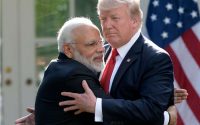Blind lawyer Pankaj Sinha, 35, fights for leprosy patients ignored by society
Source:- dailymail.co.uk
Advocates and litigants in the courtroom sympathize as he is led up the aisle to the desk by an assistant.
But the moment he begins to make the submissions running his fingers over bulky notes prepared in braille, it becomes clear that 35-year-old lawyer Pankaj Sinha cannot to be taken lightly and is on par with any leading lawyer.
At his age, when most lawyers struggle to establish themselves in the profession, Sinha has already brought light to the life of thousands of visually impaired and differently-abled.
He has hit headlines, after securing an Court verdict which allows the hearing impaired to drive.
He also got the Delhi University to ensure that the study material for all the courses, is made accessible to the visually-impaired students, before introduction of the four-year undergraduate programme.
Pankaj has also successfully challenged the central postal life insurance in which a disabled person is charged more premium and given less money.
He forced the Centre to introduce unique identity cards to enable differently- abled book railway tickets on the internet and avail concessions.
He now awaits a landmark order from the Supreme Court in a PIL he filed in 2014, taking up the cause of leprosy-affected people.
India has 62 % of the world’s leprosy population with 1.25 lakh people affected by the disease annually.
‘I was disturbed by the ostracization of leprosy-affected people. These people are segregated in separate colonies due to fear of the disease spreading though modern science has taught us that leprosy is curable,’ Sinha says.
In response to his PIL, the Supreme Court prodded the Centre to take steps in this regard, following which the Centre filed an affidavit in 2015 saying that diagnosis and treatment of leprosy was being integrated into the general health care system for the first time.
‘This is done so that the treatment of leprosy patients is more accessible, and systematically followed up, and the social stigma is reduced considerably.’
The judgement will encourage and facilitate more leprosy patients to seek health care,’ the Centre said.
Asking the government to be more aggressive in its efforts to eradicate leprosy, the Supreme Court had expressed concern that people were still suffering from the disease.
The court pointed out that despite the availability of multi-drug therapy (MDT) in the country since 1981.
‘This is a case which should have been taken up on a priority basis. Leprosy, as of today, is curable and because of apathy shown by the authorities, and it still remains a stigma,’ the court had said.
Sinha sought the court’s direction to make MDT available at primary health centres across the country



